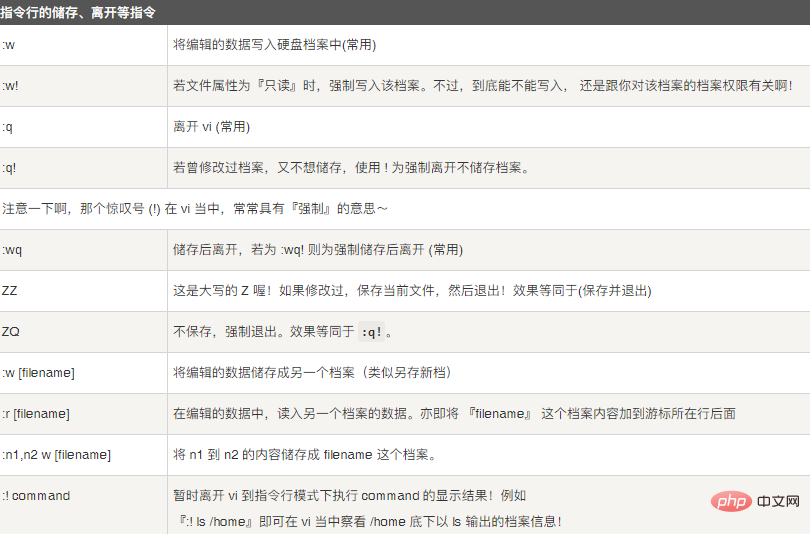 Operation and Maintenance
Operation and Maintenance
 Linux Operation and Maintenance
Linux Operation and Maintenance
 How to save vim without exiting in linux
How to save vim without exiting in linux
How to save vim without exiting in linux
In Linux, vim can use the ":w" or ":w!" command to save the file without exiting. vim is a text editor in Linux. The ":w" command can be used to save the file directly without exiting. To exit editing, use the ":w!" command to force save the file when the file is read-only without exiting editing. "!" means forced.

#The operating environment of this tutorial: linux7.3 system, Dell G3 computer.
How to save vim in Linux without exiting
:w - Save the file without exiting the editor
:w! - Force save the file without exiting the editor
vim
Vim is developed from vi a text editor. It is particularly rich in functions that facilitate programming, such as code completion, compilation, and error jumping, and is widely used among programmers.
To put it simply, vi is an old-fashioned word processor, but its functions are already very complete, but there is still room for improvement. vim can be said to be a very useful tool for program developers.
Basically, vi/vim is divided into three modes, namely command mode (Command mode), input mode (Insert mode) and bottom line command mode (Last line mode). The functions of these three modes are:
Command mode:
The user has just started vi/vim and entered the command mode.
In this state, keystrokes will be recognized by Vim as commands instead of character input. For example, if we press i at this time, we will not enter a character. i is treated as a command.
The following are some commonly used commands:
i Switch to input mode to enter characters.
x Delete the character at the current cursor position.
: Switch to bottom line command mode to enter commands on the bottom line.
If you want to edit text: Start Vim, enter command mode, press i to switch to input mode.
The command mode only has some of the most basic commands, so you still have to rely on the bottom line command mode to enter more commands.
Input mode
Press i in command mode to enter input mode.
In the input mode, you can use the following keys:
character keys and Shift combination to enter the characters
ENTER, Enter key, line feed
BACK SPACE, backspace key, delete the character before the cursor
DEL, delete key, delete the character after the cursor Character
arrow keys, move the cursor in the text
HOME/END, move the cursor to the beginning/end of the line
Page Up/Page Down, page up/down
-
Insert, switch the cursor to input/replace mode, the cursor will become a vertical line/underline
ESC, exit input mode and switch to command mode
Bottom line command mode
In command mode Press: (English colon) to enter the bottom line command mode.
Bottom line command mode allows you to enter single or multiple character commands, and there are many available commands.
In the bottom line command mode, the basic commands are (the colon has been omitted):
q Exit the program
w Save file

##Expand knowledge
- :w - Save the file without exiting editing
- :wq - Save the file without exiting editing
- :w! - Forcefully save the file without exiting the editor
- :wq! - Forcefully save the file without exiting the editor
- :w file - save the changes to file without exiting the editor
- :q - exit the editor without saving the file
- :q! - no Save the file and force quit editing
- :e - discard all changes (from the last time the file was saved)

The above is the detailed content of How to save vim without exiting in linux. For more information, please follow other related articles on the PHP Chinese website!

Hot AI Tools

Undresser.AI Undress
AI-powered app for creating realistic nude photos

AI Clothes Remover
Online AI tool for removing clothes from photos.

Undress AI Tool
Undress images for free

Clothoff.io
AI clothes remover

Video Face Swap
Swap faces in any video effortlessly with our completely free AI face swap tool!

Hot Article

Hot Tools

Notepad++7.3.1
Easy-to-use and free code editor

SublimeText3 Chinese version
Chinese version, very easy to use

Zend Studio 13.0.1
Powerful PHP integrated development environment

Dreamweaver CS6
Visual web development tools

SublimeText3 Mac version
God-level code editing software (SublimeText3)

Hot Topics
 1387
1387
 52
52
 How to use docker desktop
Apr 15, 2025 am 11:45 AM
How to use docker desktop
Apr 15, 2025 am 11:45 AM
How to use Docker Desktop? Docker Desktop is a tool for running Docker containers on local machines. The steps to use include: 1. Install Docker Desktop; 2. Start Docker Desktop; 3. Create Docker image (using Dockerfile); 4. Build Docker image (using docker build); 5. Run Docker container (using docker run).
 How to view the docker process
Apr 15, 2025 am 11:48 AM
How to view the docker process
Apr 15, 2025 am 11:48 AM
Docker process viewing method: 1. Docker CLI command: docker ps; 2. Systemd CLI command: systemctl status docker; 3. Docker Compose CLI command: docker-compose ps; 4. Process Explorer (Windows); 5. /proc directory (Linux).
 What to do if the docker image fails
Apr 15, 2025 am 11:21 AM
What to do if the docker image fails
Apr 15, 2025 am 11:21 AM
Troubleshooting steps for failed Docker image build: Check Dockerfile syntax and dependency version. Check if the build context contains the required source code and dependencies. View the build log for error details. Use the --target option to build a hierarchical phase to identify failure points. Make sure to use the latest version of Docker engine. Build the image with --t [image-name]:debug mode to debug the problem. Check disk space and make sure it is sufficient. Disable SELinux to prevent interference with the build process. Ask community platforms for help, provide Dockerfiles and build log descriptions for more specific suggestions.
 What computer configuration is required for vscode
Apr 15, 2025 pm 09:48 PM
What computer configuration is required for vscode
Apr 15, 2025 pm 09:48 PM
VS Code system requirements: Operating system: Windows 10 and above, macOS 10.12 and above, Linux distribution processor: minimum 1.6 GHz, recommended 2.0 GHz and above memory: minimum 512 MB, recommended 4 GB and above storage space: minimum 250 MB, recommended 1 GB and above other requirements: stable network connection, Xorg/Wayland (Linux)
 vscode cannot install extension
Apr 15, 2025 pm 07:18 PM
vscode cannot install extension
Apr 15, 2025 pm 07:18 PM
The reasons for the installation of VS Code extensions may be: network instability, insufficient permissions, system compatibility issues, VS Code version is too old, antivirus software or firewall interference. By checking network connections, permissions, log files, updating VS Code, disabling security software, and restarting VS Code or computers, you can gradually troubleshoot and resolve issues.
 Can vscode be used for mac
Apr 15, 2025 pm 07:36 PM
Can vscode be used for mac
Apr 15, 2025 pm 07:36 PM
VS Code is available on Mac. It has powerful extensions, Git integration, terminal and debugger, and also offers a wealth of setup options. However, for particularly large projects or highly professional development, VS Code may have performance or functional limitations.
 What is vscode What is vscode for?
Apr 15, 2025 pm 06:45 PM
What is vscode What is vscode for?
Apr 15, 2025 pm 06:45 PM
VS Code is the full name Visual Studio Code, which is a free and open source cross-platform code editor and development environment developed by Microsoft. It supports a wide range of programming languages and provides syntax highlighting, code automatic completion, code snippets and smart prompts to improve development efficiency. Through a rich extension ecosystem, users can add extensions to specific needs and languages, such as debuggers, code formatting tools, and Git integrations. VS Code also includes an intuitive debugger that helps quickly find and resolve bugs in your code.
 How to back up vscode settings and extensions
Apr 15, 2025 pm 05:18 PM
How to back up vscode settings and extensions
Apr 15, 2025 pm 05:18 PM
How to back up VS Code configurations and extensions? Manually backup the settings file: Copy the key JSON files (settings.json, keybindings.json, extensions.json) to a safe location. Take advantage of VS Code synchronization: enable synchronization with your GitHub account to automatically back up all relevant settings and extensions. Use third-party tools: Back up configurations with reliable tools and provide richer features such as version control and incremental backups.



